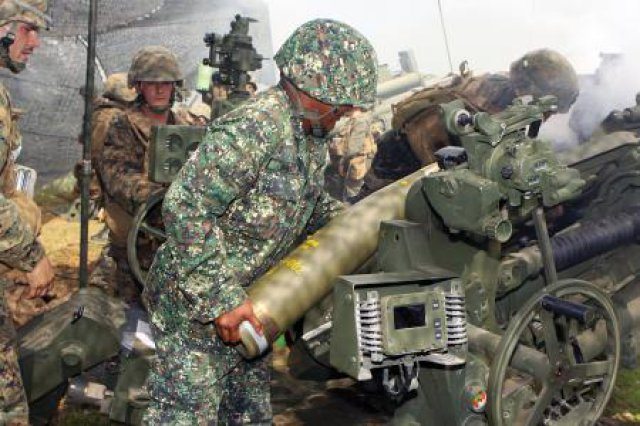Picatinny munitions experts have developed a process to recycle a family of old artillery shells to create less expensive, more realistic and safer training rounds for Soldiers, giving new meaning to the slogan “renew, reuse, recycle.”
Their process, which begins with old, obsolete 155 mm M483 Dual-Purpose Improved Conventional Munitions, or DPICM, shell bodies scheduled for demilitarization, proposes to save the Army as much as $10 million per year averaged over the next 20 years.
The old shell bodies and bases were originally going to be sold as scrap metal. However, the M1122 program salvages the old projectile body and base, removes and demilitarizes the submunitions, and reuses the metal parts to produce 155mm M1122 High Explosive, HE, rounds. The M1122 will be the primary 155mm training projectile for HE artillery fire missions. It will replace the 155mm M804A1 Practice Projectile and M107 HE Projectile, which are more expensive, for training.
“It’s a win-win situation,” Kondas said of the M1122 Program. “It’s cheaper than the M804A1 that we use for training and the M107 that we use for training and combat. At the same time we’re reducing the total quantity of DPICM rounds that have to be disposed.”
In addition to being less expensive, the M1122 has been designed to maintain ballistic similitude, appearance and function of the 155mm M795 HE Projectile.
“The M795 has a range of 22 kilometers. For the past ten or fifteen years, to save money, the Army has been using the M107 for training,” said Marty Moratz, chief of the Conventional Ammunition Division for PM CAS. “It only goes to 17 kilometers, it weighs less than the M795, has less explosive fill, but is a lot less expensive than the M795. So Soldiers were getting good, realistic training, but they weren’t training the way they were fighting.”
“But the M1122 is basically the same as the M795 — it weighs the same as the M795, it flies the same way as the M795, it has the same range,” he added.
SAFER AND CHEAPER
“We’re actually enhancing the way Soldiers train, doing it at a significant cost savings and helping address the demilitarization issue,” Moratz said.
The M1122 rounds also contain Insensitive Munitions Explosive-101 (IMX-101) which makes them safer for U.S. Soldiers. IMX-101 replaces TNT and is a more-stable explosive fill. It has the same explosive effects as traditional TNT, but is safer for Soldiers because it is far less likely to explode if in a fire, shot at or hit by a roadside bomb during transport.
“Once the M1122 Program reaches full rate production, the M1122 rounds filled with IMX-101 are anticipated to cost $27 cheaper than an M107 filled with TNT, and $131 less than what an M107 filled with IMX-101 would cost,” Moratz said.
DEMILITARIZATION
To carry out the M1122 program, PM CAS employees teamed up with the Product Manager for Demilitarization, also at Picatinny, on the DPICM demilitarization efforts. The M483 demil and M1122 production currently takes place at McAlester Army Ammunition Plant in McAlester, Okla.
“The Army produced approximately 3.6 million M483s,” said Moratz. “Over a million of the M483 rounds are scheduled for demil and the expectation is that all of them will be disposed of.”
With funding from the Office of the Secretary of Defense, the M1122 was developed by the Armament Research, Development and Engineering Center at Picatinny. The U.S. Government owns all the data rights to the round.
The M1122 rounds achieved Full Materiel Release, known as FMR, on June 22, 2012. FMR means that the rounds have been declared safe, reliable, operationally sustainable and effective. M1122 rounds built last year under Initial Production were recently placed in the Army inventory ready for troop use.
The program is currently scheduled to build approximately 280,000 M1122 rounds through 2018.
The M1122 Program has also paved the way for three additional programs that will use DPICM shell bodies to create new tactical projectiles: XM1123 Infrared Illuminating Projectiles, XM1124 Visible Light Illuminating Projectiles and M110A3 White Phosphorous Smoke Projectiles.
The XM1123 and XM1124 are currently being qualified for use by the USA and USMC under the Joint Extended Range Illumination Projectiles Joint Capability Technology Demonstration project being sponsored by the Office of the Secretary of Defense.










